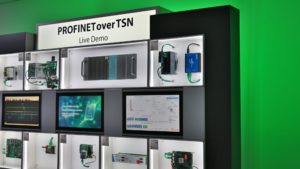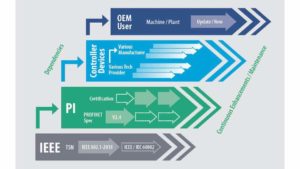In a previous article in this space, we discussed how one of our goals at PROFIBUS & PROFINET International (PI) is to make technologies like Time Sensitive Networking easy to use. The focus was on end-customers. Here, we would again like to focus on usability, but focus on device vendors – automation companies building TSN-capable products and what PI is doing to ease adoption here as well.
PROFINET Community Software Stack
 The first way we at PI are helping automation device vendors to adopt TSN is via the release of the PROFINET Community [software] Stack. This portable software stack provides core functions required by PROFINET-enabled devices. These core functions can then be adapted (downwards) to the specific hardware upon which the stack is being implemented, and (upwards) to the application software that will utilize it. From the outset the PROFINET Community Stack has been developed and released with TSN integration in mind.
The first way we at PI are helping automation device vendors to adopt TSN is via the release of the PROFINET Community [software] Stack. This portable software stack provides core functions required by PROFINET-enabled devices. These core functions can then be adapted (downwards) to the specific hardware upon which the stack is being implemented, and (upwards) to the application software that will utilize it. From the outset the PROFINET Community Stack has been developed and released with TSN integration in mind.
Available to PI members, the stack can be downloaded for free from the PI website. It is intended primarily for PROFINET solution providers or technology partners, and secondarily for the device vendors themselves. It gives our technology partners a foundation upon which to build their software stacks that make it easy for device vendors to add PROFINET to their products. They are the experts in helping add PROFINET to a device and can be consulted at any point during the integration process.
Easy PROFINET + TSN Testing
 Every PROFINET-enabled device is required to pass conformance testing and certification before it can be released on the market. The same test tool used by PI test labs to put devices through their paces is available for download and use by device vendors themselves. It is an automated tester that steps through test cases and gives simple stoplight results with each test case performed. As TSN requires clock synchronization, hardware support is needed in the devices via TSN-capable Ethernet chips. So must the hardware employed by the test tool also have such hardware support.
Every PROFINET-enabled device is required to pass conformance testing and certification before it can be released on the market. The same test tool used by PI test labs to put devices through their paces is available for download and use by device vendors themselves. It is an automated tester that steps through test cases and gives simple stoplight results with each test case performed. As TSN requires clock synchronization, hardware support is needed in the devices via TSN-capable Ethernet chips. So must the hardware employed by the test tool also have such hardware support.
Therefore, to ease TSN integration, the latest version of the PROFINET test tool has been developed to use a widely available, commercial-off-the-shelf (COTS) development kit for the TSN functionality. It is called ETS: Embedded Test System. The test tool runs on any laptop and initiates the test cases via the connected TSN dev kit (ETS). In this way it is ensured that device vendors can easily run through test cases themselves via this COTS-obtainable hardware.
Conclusion
 Automation component makers should focus their efforts on building out the feature-functionality of their devices. Meanwhile, integration of a communication interface should be as painless as possible. With the PROFINET Community Stack and COTS hardware for automated TSN testing, PI is helping device vendors in this way. We want to enable adoption of TSN at end customers, by easing its integration for device vendors.
Automation component makers should focus their efforts on building out the feature-functionality of their devices. Meanwhile, integration of a communication interface should be as painless as possible. With the PROFINET Community Stack and COTS hardware for automated TSN testing, PI is helping device vendors in this way. We want to enable adoption of TSN at end customers, by easing its integration for device vendors.
